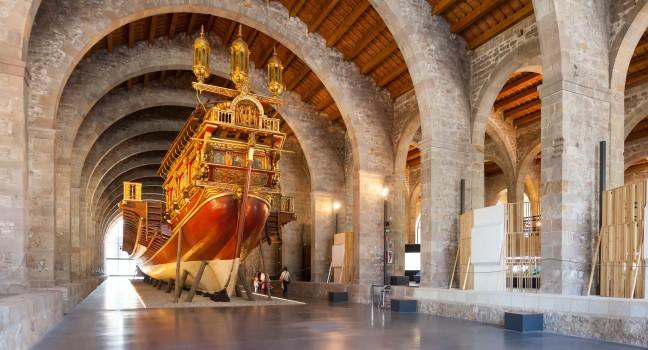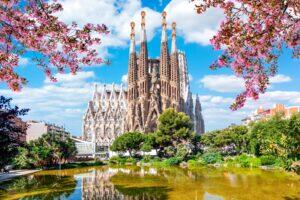Fodor's Expert Review Museu Marítim

This superb museum is housed in the 13th-century Drassanes Reials (Royal Shipyards), at the foot of La Rambla adjacent to the harborfront. This vast covered complex launched the ships of Catalonia's powerful Mediterranean fleet directly from its yards into the port (the water once reached the level of the eastern facade of the building). Today, these are the world's largest and best-preserved medieval shipyards. Centuries ago, at a time when the region around Athens was a province of the House of Aragón (1311–90), they were of crucial importance to the sea power of Catalonia (then the heavyweight in an alliance with Aragón).
On the Avinguda del Paral·lel side of Drassanes is a completely intact section of the 14th- to 15th-century walls—Barcelona's third and final ramparts—that encircled El Raval along the Paral·lel and the Rondas de Sant Pau, Sant Antoni, and Universitat. (Ronda, the term used for the "rounds," or patrols soldiers made atop the defensive walls,... READ MORE
This superb museum is housed in the 13th-century Drassanes Reials (Royal Shipyards), at the foot of La Rambla adjacent to the harborfront. This vast covered complex launched the ships of Catalonia's powerful Mediterranean fleet directly from its yards into the port (the water once reached the level of the eastern facade of the building). Today, these are the world's largest and best-preserved medieval shipyards. Centuries ago, at a time when the region around Athens was a province of the House of Aragón (1311–90), they were of crucial importance to the sea power of Catalonia (then the heavyweight in an alliance with Aragón).
On the Avinguda del Paral·lel side of Drassanes is a completely intact section of the 14th- to 15th-century walls—Barcelona's third and final ramparts—that encircled El Raval along the Paral·lel and the Rondas de Sant Pau, Sant Antoni, and Universitat. (Ronda, the term used for the "rounds," or patrols soldiers made atop the defensive walls, became the name for the avenues that replaced them.)
The Museu Marítim is filled with vessels, including a spectacular collection of ship models. The life-size reconstruction of the galley of Juan de Austria, commander of the Spanish fleet in the Battle of Lepanto, is perhaps the most impressive display in the museum. Figureheads, nautical gear, early navigational charts, and medieval nautical lore enhance the experience, and headphones and infrared pointers provide a first-rate self-guided tour.
Concerts are occasionally held in this acoustic gem. The cafeteria-restaurant Norai, open daily 9 am to 8 pm, offers dining in a setting of medieval elegance, and has a charming terrace. Admission to the museum includes a visit to the schooner Santa Eulàlia, a meticulously restored clipper built in 1918, which is moored nearby at the Port Vell.
READ LESS








